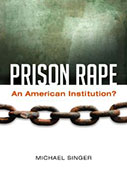Prison Rape: An American Institution?

Author: Michael Singer
Publisher: Santa Barbara, CA: Praeger, 2013
Reviewer: Cindy Struckman-Johnson, Ph.D. | November 2014
While reading the introduction to Michael Singer’s seminal book on prison rape, I was flooded with memories from 1994 when my colleagues and I were completing our first study of sexual coercion in prisons. I was summoned to a prison facility in the Midwest to give the Department of Corrections (DOC) feedback about our survey results. I remember being swept up by the dramatic results: 21% of male prisoners in our sample had experienced sexual contact against their will while incarcerated. Nearly 12% of the male inmates had reported an incident of rape involving forced anal or oral sex. Correctional staff, as well as inmates, were implicated as perpetrators. In my naiveté, I expected the administration to be called to action by this raw knowledge of abuse. Instead, I encountered the denial and fury of the DOC. Lies, lies, all inmate lies, they insisted! I left in a dazed state, unable to convince them that prison rape is real and must be reckoned with (Struckman-Johnson, 1998). How gratifying then to read, 20 years later, Dr. Singer’s dissection of how the historical resistance to address prison rape in America is succumbing to social, legal, and legislative forces.
The author is a law professor with advanced degrees from Cambridge, the University of London, and Stanford. He has authored or co-authored books on juries, laws of evidence, and the philosophy of positivism. Dr. Singer combines a professorial knowledge of the US criminal justice system with an activist’s moral desire to alleviate harms brought about by prison rape. As he writes in the introduction, “…moral honesty demands that we acknowledge our shame in the existence of systemic sexual abuse in the incarceration system and the exploitation of that sexual abuse. This shame is a moral cost on all of us and on our society as a whole” (p. xii). Singer has conducted exhaustive research on prison rape, listing over 500 footnotes, legal citations, and references to academic and government works. Yet the book, written with lucid, eloquent language, is highly readable and suitable for a broad audience. I would recommend it for college students, law students, faculty, legal scholars, criminal justice and corrections professionals, investigative journalists, and activists for prison reform and human rights. All readers should be prepared for disturbing and often gut-wrenching information about events happening in the American prison system.
Singer begins with a useful review of the infrastructure of the US criminal justice system (e.g., prisons, jails, lock-ups, juvenile facilities). He notes that the current US prison population is about 1.6 million, but adds the startling Department of Justice (DOJ) estimate that 13.4 million people are arrested and pass through jails or lockups each year (p. 5). He then defines prison rape as “all forms of sexual abuse in all forms of incarceration“(p. 5). By combining acts of sexual touching (e.g., genital or breast fondling) with forced anal or oral sex, Singer may be criticized for overestimating acts that would not meet legal definitions of rape. However, the terms “prison rape” and “prison sexual abuse” were adopted by the National Prison Rape Elimination Commission as catch-all terms for the full range of unwanted sexual contact (NPREC, 2009). Singer does distinguish between rates of all acts of sexual abuse versus rates of actions committed with violence. When defining terms, he states that consensual sex among inmates is not a topic of his book. However, citing the classic writing of prison rape survivor Stephen Donaldson, Singer questions whether inmates can truly consent to sex in conditions where their survival may depend upon compliance.
The first chapter is a review of the early studies, reports, and legal cases (1960 – early 2000’s) that led to societal acknowledgement of prison rape. Exposes of pervasive sexual abuse in prisons by Human Rights Watch in concert with activism by Stop Prisoner Rape (now Just Detention International) were key. Our research on sexual coercion in Midwestern prisons is featured, along with the methodological difficulties of assessing prison rape when victims fear exposure and retaliation by other inmates and staff. Chapter 2 moves ahead to how the passage of the Prison Rape Elimination Act (PREA) in 2003 mandated annual assessment of nation-wide levels of prison rape by the Bureau of Justice Statistics (BJS). For those wanting to know the prevalence of prison rape, the overview of the BJS studies released in 2006 – 2012 is invaluable. Perhaps because of his advanced degree in mathematics from Cambridge, Dr. Singer is able to decode the complex methodology and results of the BJS studies. Further, he explains how another PREA entity, the Regulatory Impact Assessment (RIA), has produced the most reliable estimates available on the prevalence of prison rape in American prisons: each year from 149,200 to 209,400 inmates are sexually abused. Of these, 55,400 to 82,800 inmates are violently or repeatedly raped (p. 34).
In part II, the costs associated with these numbers are addressed from three perspectives. The psychological and physical damages of prison rape are described in personal accounts of victims drawn from PREA reports, court testimony, letters to human rights organizations, and research studies. Citing past researcher Alan Davis’s decision not to “prettify” raw and ugly victim stories, Singer presents these accounts in unexpurgated language. He spotlights the poor medical care available to victims in the aftermath of an attack. For example, a female victim of forced sodomy who complained of continuous pain and bleeding was treated ineffectively with Milk of Magnesia for two years before she was allowed surgery to repair a torn rectum (p. 53). The social and economic costs of prison rape such as medical expenses and lost quality of life are presented via unemotional mathematical formulas generated by the RIA. The official estimated cost range of prison sexual abuse for one year is an astonishing $26.9 to $51.9 billion (p. 71). Finally, the moral costs to the stature of the American justice system are considered: Correctional staff who allow prisoners to be raped for punishment; prosecutors who bully defendants with threats of prison rape; and the media who use prison rape as a form of entertainment.
Part III is dedicated to the courts’ evolving response to prison rape. Displaying his law professor credentials, Singer offers a valuable primer on how victims of prison rape can seek redress in the Federal courts. Although prison rape can be considered cruel and unusual punishment via the Eighth Amendment, a victim who files suit for violation of constitutional rights will face formidable obstacles: cumbersome grievance policies, requirements to prove deliberate indifference by authorities, statutes that restrict liability of individuals or agencies, and States’ sovereign immunity. The author notes progress for victims who seek justice through State courts: some trial judges now take into consideration an offender’s vulnerability to prison rape when deciding the location and length of sentencing. In several states, the courts have approved multi-million dollar settlements to groups of female prisoners who experienced severe levels of sexual abuse by male correctional staff. These cases, however, are rare and difficult. For example, a Michigan suit for female inmates involved 13 years of appeals and huge out-of-pocket payments by their lawyers before successfully settled (pp. 96-97).
The last part of the book is about the passage of PREA in 2003, the development of national standards for eliminating prison rape by NPREC in 2009, and the final form of the standards released by the US Attorney General in 2012. For the many who are interested in how PREA has changed the correctional response to prison rape, Singer’s review is a pure gift. To appreciate the progress, consider the circumstances described by victims in Chapter 4 and then read what the core standards mandate: training and education of staff, screening and appropriate housing for vulnerable inmates, safe ways to report victimization, investigation of incidents, medical and mental health care for victims, data collection and auditing. Singer navigates the complicated changes that occurred in the development of these standards from NPREC to the Attorney General. He further explains how PREA’s limitation on costly solutions impaired the development and the current attempts to implement the standards. As a past member of NPREC, I have actually sent illuminating excerpts from Singer’s discussions of the standards to other former Commissioners. Of particular importance is his point that the DOJ estimates of the total cost per year of implementing the standards is around $470 million, which is only 0.6% of the $80 billion annual budget (p. 138).
In these final chapters, the author explores the question of whether or not prison rape will remain an American institution. According to RIA analyses, a one-time decline of 1.5% of victims in adult facilities and 3% in juvenile facilities from present levels that is maintained annually would be enough to break even with the annual cost of implementing PREA standards. This would amount to about 2,300 victims spared the experience of prison rape (p. 139). Although Singer applauds the potential relief for thousands of victims, he questions whether this small decline is meaningful. Even a 50% decline would leave nearly 75,000 victims experiencing sexual abuse annually (p. 142). Hemet be overly-pessimistic about the potential success of PREA. One of his concerns is that the states will refuse to comply with the voluntary PREA standards. Since publication of his book, seven states (AZ, FL, ID, IN, NE, TX, & UT). have signaled their refusal to adopt PREA standards. However, a reassuring total of 48 states and territories are in stages of partial or full compliance (DOJ, 2014, May).
Singer also expresses doubts about the ability of corrections leaders to commit their institutions to eliminating prison rape. Although he acknowledges the progressive work of some leaders in corrections (e.g., Sheriff Hennessey in San Francisco jails; the Oregon DOC’s work with JDI), he writes: “[a] substantial number of state and local correctional authorities have been indifferent to pervasive sexual abuse in their facilities…Many of these authorities are likely to stubbornly resist change” (p. 143). There may be room for more optimism about leadership. Despite my own encounters with the culture of resistance, through NPREC, I have since become aware of scores of correctional professionals who have long worked to end prison rape and welcome PREA. These individuals and the agencies they represent need more time, more resources, and greater recognition of their efforts before we can prophesize the fate of PREA (Struckman-Johnson & Struckman-Johnson, 2013). As we move forward into the next ten years of prison reform, great thanks are owed to Michael Singer for issuing the compelling challenge to de-institutionalize prison rape.
References
Department of Justice. (2014, May). States’ and territories’ responses to the May 15, 2014 Prison Rape Elimination Act Deadline. Washington, DC: US Bureau of Justice. Retrieved on July 28, 2014, from: http://www.bja.gov/Programs/PREAcompliance.pdf
National Prison Rape Elimination Commission (2009, June). National prison rape elimination commission report. Washington DC: Author. Retrieved from: https://www.ncjrs.gov/pdffiles1/226680.pdf.
Struckman-Johnson, C. (1998). Breaking into prison: The story of a study of sexual coercion among incarcerated men and women. In G. Brannigan, E. Allgeier, & A. Allgeier (Eds). The sex scientists (pp. 171-184). New York: Longman.
Struckman-Johnson, C., & Struckman-Johnson, D. (2013). Stopping prison rape: The evolution of standards recommended by PREA’s National Prison Rape Elimination Commission. The Prison Journal, 93, 335-356.


